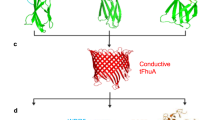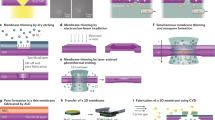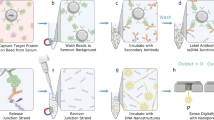Abstract
Monitoring the binding affinities and kinetics of protein interactions is important in clinical diagnostics and drug development because such information is used to identify new therapeutic candidates. Surface plasmon resonance is at present the standard method used for such analysis, but this is limited by low sensitivity and low-throughput analysis. Here, we show that silicon nanowire field-effect transistors can be used as biosensors to measure protein–ligand binding affinities and kinetics with sensitivities down to femtomolar concentrations. Based on this sensing mechanism, we develop an analytical model to calibrate the sensor response and quantify the molecular binding affinities of two representative protein–ligand binding pairs. The rate constant of the association and dissociation of the protein–ligand pair is determined by monitoring the reaction kinetics, demonstrating that silicon nanowire field-effect transistors can be readily used as high-throughput biosensors to quantify protein interactions.
This is a preview of subscription content, access via your institution
Access options
Subscribe to this journal
Receive 12 print issues and online access
$259.00 per year
only $21.58 per issue
Buy this article
- Purchase on Springer Link
- Instant access to full article PDF
Prices may be subject to local taxes which are calculated during checkout




Similar content being viewed by others
References
Boccaletti, S., Latora, V., Moreno, Y., Chavez, M. & Hwang, D. U. Complex networks: structure and dynamics. Phys. Rep. 424, 175–308 (2006).
Wilson, G. S. & Gifford, R. Biosensors for real-time in vivo measurements. Biosens. Bioelectron. 20, 2388–2403 (2005).
Cheng, M. M. C. et al. Nanotechnologies for biomolecular detection and medical diagnostics. Curr. Opin. Chem. Biol. 10, 11–19 (2006).
D'Orazio, P. Biosensors in clinical chemistry. Clin. Chim. Acta 334, 41–69 (2003).
Arlett, J. L., Myers, E. B. & Roukes, M. L. Comparative advantages of mechanical biosensors. Nature Nanotech. 6, 203–215 (2011).
Cooper, M. A. Optical biosensors in drug discovery. Nature Rev. Drug Discov. 1, 515–528 (2002).
Curreli, M. et al. Real-time, label-free detection of biological entities using nanowire-based FETs. IEEE Trans. Nanotech. 7, 651–667 (2008).
Stern, E., Vacic, A. & Reed, M. A. Semiconducting nanowire field-effect transistor biomolecular sensors. IEEE Trans. Electron Dev. 55, 3119–3130 (2008).
Cui, Y. & Lieber, C. M. Functional nanoscale electronic devices assembled using silicon nanowire building blocks. Science 291, 851–853 (2001).
Stern, E. et al. Label-free immunodetection with CMOS-compatible semiconducting nanowires. Nature 445, 519–522 (2007).
Wang, W. U., Chen, C., Lin, K. H., Fang, Y. & Lieber, C. M. Label-free detection of small-molecule–protein interactions by using nanowire nanosensors. Proc. Natl Acad. Sci. USA 102, 3208–3212 (2005).
De Vico, L. et al. Quantifying signal changes in nano-wire based biosensors. Nanoscale 3, 706–717 (2011).
Bunimovich, Y. L. et al. Quantitative real-time measurements of DNA hybridization with alkylated nonoxidized silicon nanowires in electrolyte solution. J. Am. Chem. Soc. 128, 16323–16331 (2006).
Squires, T. M., Messinger, R. J. & Manalis, S. R. Making it stick: convection, reaction and diffusion in surface-based biosensors. Nature Biotechnol. 26, 417–426 (2008).
Tian, J. et al. Toll-like receptor 9-dependent activation by DNA-containing immune complexes is mediated by HMGB1 and RAGE. Nature Immunol. 8, 487–496 (2007).
Li, Y., Berk, I. C. & Modis, Y. DNA binding to proteolytically activated TLR9 is sequence-independent and enhanced by DNA curvature. EMBO J. 31, 919–931 (2012).
Wilchek, M. & Bayer, E. A. Introduction to avidin-biotin technology. Methods Enzymol. 184, 5–13 (1990).
Balasubramanian, K. Challenges in the use of 1D nanostructures for on-chip biosensing and diagnostics: a review. Biosens. Bioelectron. 26, 1195–1204 (2011).
Ishikawa, F. N. et al. A calibration method for nanowire biosensors to suppress device-to-device variation. ACS Nano 3, 3969–3976 (2009).
Lee, B. Y. et al. Universal parameters for carbon nanotube network-based sensors: can nanotube sensors be reproducible? ACS Nano 5, 4373–4379 (2011).
Abe, M. et al. Quantitative detection of protein using a top-gate carbon nanotube field effect transistor. J. Phys. Chem. C 111, 8667–8670 (2007).
Myszka, D. G., He, X., Dembo, M., Morton, T. A. & Goldstein, B. Extending the range of rate constants available from BIACORE: interpreting mass transport-influenced binding data. Biophys. J. 75, 583–594 (1998).
Gaster, R. S. et al. Quantification of protein interactions and solution transport using high-density GMR sensor arrays. Nature Nanotech. 6, 314–320 (2011).
Elfstroem, N., Karlstroem, A. E. & Linnrost, J. Silicon nanoribbons for electrical detection of biomolecules. Nano Lett. 8, 945–949 (2008).
Sheehan, P. E. & Whitman, L. J. Detection limits for nanoscale biosensors. Nano Lett. 5, 803–807 (2005).
Bergveld, P. A critical-evaluation of direct electrical protein-detection methods. Biosens. Bioelectron. 6, 55–72 (1991).
Stern, E. et al. Importance of the debye screening length on nanowire field effect transistor sensors. Nano Lett. 7, 3405–3409 (2007).
Bianchi, M. E., Beltrame, M. & Paonessa, G. Specific recognition of cruciform DNA by nuclear-protein HMG1. Science 243, 1056–1059 (1989).
Ivanov, S. et al. A novel role for HMGB1 in TLR9-mediated inflammatory responses to CpG-DNA. Blood 110, 1970–1981 (2007).
Ohndorf, U. M., Rould, M. A., He, Q., Pabo, C. O. & Lippard, S. J. Basis for recognition of cisplatin-modified DNA by high-mobility-group proteins. Nature 399, 708–712 (1999).
Pil, P. M. & Lippard, S. J. Specific binding of chromosomal protein-HMG1 to DNA damaged by the anticancer drug cisplatin. Science 256, 234–237 (1992).
Halford, S. E. & Marko, J. F. How do site-specific DNA-binding proteins find their targets? Nucleic Acids Res. 32, 3040–3052 (2004).
Jung, Y. & Lippard, S. J. Nature of full-length HMGB1 binding to cisplatin-modified DNA. Biochemistry 42, 2664–2671 (2003).
Perez-Luna, V. H. et al. Molecular recognition between genetically engineered streptavidin and surface-bound biotin. J. Am. Chem. Soc. 121, 6469–6478 (1999).
Jung, L. S., Nelson, K. E., Stayton, P. S. & Campbell, C. T. Binding and dissociation kinetics of wild-type and mutant streptavidins on mixed biotin-containing alkylthiolate monolayers. Langmuir 16, 9421–9432 (2000).
Buranda, T. et al. Ligand receptor dynamics at streptavidin-coated particle surfaces: a flow cytometric and spectrofluorimetric study. J. Phys. Chem. B 103, 3399–3410 (1999).
Tang, Y. J., Mernaugh, R. & Zeng, X. Q. Nonregeneration protocol for surface plasmon resonance: study of high-affinity interaction with high-density biosensors. Anal. Chem. 78, 1841–1848 (2006).
Acknowledgements
The authors acknowledge financial support from the Netherlands Organization for Scientific Research (NWO, Rubicon grant), the National Institutes of Health (NIH R01EB008260 and P01GM022778), the Burroughs Welcome Fund (to Y.M.) and DTRA (HDTRA1-10-1-0037). The authors thank A. Vacic, M. Weber and W. Guan for help with the electrical measurement and helpful discussions.
Author information
Authors and Affiliations
Contributions
X.D. and M.A.R. conceived and designed the experiments. X.D. performed the experiments. X.D. and N.K.R. analysed the data. N.K.R. and D.A.R. fabricated the nanowire devices. Y.L. and Y.M. contributed the DNA and proteins, and X.D. and M.A.R. co-wrote the paper.
Corresponding author
Ethics declarations
Competing interests
The authors declare no competing financial interests.
Supplementary information
Supplementary information
Supplementary information (PDF 963 kb)
Rights and permissions
About this article
Cite this article
Duan, X., Li, Y., Rajan, N. et al. Quantification of the affinities and kinetics of protein interactions using silicon nanowire biosensors. Nature Nanotech 7, 401–407 (2012). https://doi.org/10.1038/nnano.2012.82
Received:
Accepted:
Published:
Issue Date:
DOI: https://doi.org/10.1038/nnano.2012.82
This article is cited by
-
Kinetic study of membrane protein interactions: from three to two dimensions
Scientific Reports (2024)
-
Recent Advances and Prospects in Silicon Nanowire Sensors: A Critical Review
Silicon (2024)
-
Simulation of GAA-NW-TFET Biosensor with Cluster Charge Probes for Target Biomolecule Detection
Silicon (2024)
-
Catalyst-free synthesis of sub-5 nm silicon nanowire arrays with massive lattice contraction and wide bandgap
Nature Communications (2022)
-
Ionic contrast across a lipid membrane for Debye length extension: towards an ultimate bioelectronic transducer
Nature Communications (2021)



